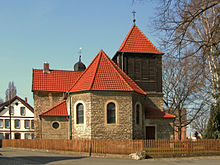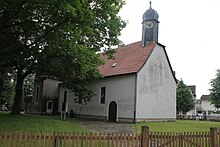St. Nicholas (Drispenstedt)
St. Nicholas is under monument protection standing Roman Catholic Church in Hildesheim district Drispenstedt . Today it belongs to the parish of Mariä Lichtmess in the Hildesheim deanery of the Hildesheim diocese .
history
The settlement Drispenstedt is mentioned in a document from 1193, in which Pope Celestine III. (1106–1198) took the Hildesheim Michaeliskloster under his protection and confirmed its ownership, which belonged to the property in Drispenstedt. The Ministerialengeschlecht of Drisminstede is mentioned in writing in the second half of the 12th century. In addition to the Johannesstift in Hildesheim and the Derneburg Monastery , the Dompropstei in particular had extensive property in Drispenstedt.
Although the documents about the first construction of a church are missing, it is likely that the settlement had a chapel during the Middle Ages. The possibility of a double patronage of St. Mary and St. Nicholas is not excluded. Together with the settlement of Bavenstedt and the Marienkapelle there, the Drispenstedt church belonged to the parish of St. Andreas in Hildesheim. As in Bavenstedt, the archdeacon of this main and baptismal church owned the patronage rights over the chapel community . The Drispenstedter and Bavenstedter parishes belonging to St. Andreas remained until the 16th century.
When St. Andrew's Church was reformed in 1542 on the initiative of the Hildesheim Old Town Council , Lutheran preachers were also sent to the subsidiary communities . The "consolidation of the Lutheran faith" in the tax forest office was particularly encouraged from 1557 by the Protestant Duke Adolf von Holstein (1526–1586). One of the first attempts at recatholization in Drispenstedt and Bavenstedt was carried out by Bishop Burchard von Oberg († February 23, 1573) in 1566, when he prohibited the pastoral care of the evangelical preacher there and commissioned the bailiff of the Steuerwald family to appoint a Catholic priest. Due to the influence of the Lutheran citizenship in Hildesheim, however, the evangelical preacher held his office until 1609. It was only under the Wittelsbach prince Ernst II of Bavaria (1554–1612) on the Hildesheim bishop's chair that a Catholic pastor could be installed in Drispenstedt and Bavenstedt in 1609. After long disputes with the citizens and the Lutheran preacher of St. Andreas, after the restitution of the Great Monastery to the Hildesheim bishop in 1643, the Catholic denomination was also secured in the parish of Steuerwald. At first Drispenstedt and Bavenstedt received pastoral care from Steuerwald.
The Nikolauskapelle was destroyed in the Thirty Years War . After 1645 it was rebuilt and given special support by the chancellor Joachim Stein , who was in the episcopal government and who owned the estate in Drispenstedt.
In the second half of the 17th century, the canons of St. Bartholomew on the Sülte were given the pastoral care of the Drispenstedt-Bavenstedt parish. The seat of the parish was from 1668 to 1803 in Drispenstedt with Bavenstedt as a branch. The first renovation and expansion of St. Nikolaus took place in 1703, supported by the von Daubner-Lützow Catholic farming family on the Drispenstedter Gut.
In 1803 a new situation arose for the parish of St. Nicholas as a result of the secularization of the Sülestift. It was without a pastor. The plan to add the parish to Asel and the Bavenstedt branch to Bettmar failed. In Bavenstedt, however, the opportunity arose to set up a parsonage in a former building of the Sülestift . After the state approval for the use of the house by the Catholic Church, the seat of the parish was moved from Drispenstedt to Bavenstedt St. Maria in 1805. The St. Nicholas community was thus a branch of Bavenstedt until 1904.
After the linking of the Drispenstedter Feldmark in the years 1850 to 1851 and the subsequent agricultural reforms, a number of large farms were established in Drispenstedt. The work opportunities on these farms initially attracted agricultural wage workers. Later, this was followed primarily by railway workers who laid a route for train traffic through the town's Feldmark. A large part of the workforce who lived in Drispenstedt came from the Catholic Eichsfeld and was employed in the Hildesheim factories. In addition, there were job opportunities in the village brickworks from 1871. From 1848 to the turn of the century, the population of the almost exclusively Catholic village had risen from 193 to 509 parishioners. That is why the Nikolauskirche was expanded from 1874 to 1875.
The further growing Nikolausgemeinde was taken into account by the church in 1904 with the elevation to the parish by Bishop Daniel Wilhelm Sommerwerck (1821-1905). With the founding, a step towards church independence was taken, but political independence was lost in 1938 when it was incorporated into Hildesheim.
The development of St. Nikolaus to a parish had started at the beginning of the 20th century with the influx of craftsmen and factory workers from Eichsfeld to Drispenstedt. After 1945 this process was continued by the Catholic refugee families from the east. The influx was so great that the “Neu-Drispenstedt” building area was built at the end of the 1950s.
Even during this construction phase, Pastor Paul Beck pointed out the need for a kindergarten and an additional church in the new building area. These plans were implemented by his successor, Pastor Erhard Hecke. After St. Nikolaus was elevated to parish on September 1, 1964, a day-care center was built in 1965 , which bears the name of the parish, and from 1974 to 1975 the larger branch church of Mariä Lichtmess in Neu-Drispenstedt.
On November 1, 2006, the new parish of Mariä Lichtmess was established, to which about 5200 Catholics belonged at that time. In this context, the parish of St. Nikolaus was abolished and, together with the churches of St. Johannes and Guter Hirt, transferred to the new parish.
Pastor Vollmer Foundation
In September 2006 the Pastor Vollmer Foundation was established. The purpose of the foundation is to preserve the listed St. Nicholas Church in Alt-Drispenstedt. The foundation was named after Theodor Vollmer (1843–1907), who was born in Drispenstedt and worked as a pastor in Hohenhameln . A part of his fortune, which he left to the St. Nicholas congregation after his death, forms the basic assets of the foundation. The foundation took over the church and the property at "Drispenstedter Brink" on November 1, 2006, when the parish of St. Nikolaus was dissolved.
Dietmar Lambrecht has been the Chairman of the Board of Trustees since 2006.
Inscription on a stone on the church
- TEMPLUM HOC AD DEI GLORIAM ET SANTISSIMAE
- GENECITRIS AC S. NICOLAI EJUS PATRONIS HONORE
- RENOVATUM ET EXTENSUM EST ANNO 1703
- This house of God became the glory of God and the Most Holy Mother of God
- and renovated and expanded in 1703 in honor of its patron St. Nicholas
architecture
The church building, which began after 1645, consists of baroque forms with a Romanesque choir. In the early 1960s, the chancel was redesigned and modernized. The wooden high altar , which was infected by the woodworm , was removed and replaced with a stone altar. After the Second Vatican Council and the associated liturgical reform , this was converted into a popular altar .
Bells
The bronze Santa Claus bell dates from 1636. Since it has no electric drive, it is only rung by hand today on the patron saint of St. Nicholas on December 6th. During the Second World War it was confiscated by the Reich Ministry of Economics to be melted down and used in the armaments industry . After the end of the war, she was found undamaged in the Hamburg bell cemetery and brought back to Drispenstedt by the Committee for the Return of Bells (ARG). It was previously housed in the roof turret and was given a new place in the bell tower.
After the First World War , the Nikolauskirche received a bell tower, this time sponsored by the Protestant farming family Brandis , who at that time managed the Drispenstedter Gut. It contains three steel bells that are electrically powered.
Tower clock
In 1945 a tower clock was installed in the roof turret in place of the Nikolaus bell, which had been believed to be lost. The unchanged mechanical clock from JF Weule from Bockenem am Harz still strikes punctually every quarter of an hour.
cenotaph
On the north aisle is the memorial built in 1918 for fallen soldiers from Drispenstedt, where the state and church commemoration ceremony takes place on the day of national mourning. In 1979 it was rededicated by the parish of St. Nicholas as a memorial for all victims of war and terror. In the early 1990s the monument from Drispenstedter Ortsrat received a new bronze plaque with the names of fallen soldiers of both World Wars.
Pastor of the independent parish (1904-2006)
- 1904–1906 Eduard Hunold
- 1906–1910 Karl Nörthemann
- 1910–1913 Ernst Algermissen
- 1913–1916 Hermann Klapprott
- 1916–1918 Bernhard Stange
- 1918–1926 Friedrich Streicher
- 1926–1929 Johannes Ewen
- 1929–1935 Georg Große
- 1935–1940 Franz Brümann
- 1940-1946 Paul Godehard
- 1946–1951 Josef Haller
- 1951–1955 Max Lorsbach
- 1955–1963 Paul Beck
- 1963–1985 Erhard Hecke
- 1985–1999 Johannes Wahlich
- 1999–2006 Dr. Werner Schreer
- 1999–2002 Dr. Alois Jeczek (cooperator)
- 2003–2006 Günter Birken (cooperator)
literature
- Heinrich Bertram: The Nikolauskirche in Drispenstedt. An old Drispenstedt tells in a publication about the consecration of the Candlemas Church , Drispenstedt 1975
- Angelika Kroker: Drispenstedt - A village in the wake of the city , Volume 20 of the series of publications of the City Archives and City Library Hildesheim, Bernward Verlag Hildesheim 1990, ISBN 3-87065-565-8
- Wilhelm Machens: The former monastery landscape in the area of today's Hildesheim in The Diocese of Hildesheim 53 pages 103-105, Hildesheim 1985
- Willi Stoffers: Diocese of Hildesheim today , pages 14–15, ISBN 3-87065-418-X , Bonifatiuswerk, Hildesheim 1987
Web links
- Parish of Mariä Candlemas in Hildesheim
Individual evidence
- ↑ Bischöfliches Generalvikariat Hildesheim (ed.): Handbook of the Diocese of Hildesheim, Part 1 - Region Hildesheim , pages 57–59, self-published, Hildesheim 1992
- ↑ Festschrift for the 25th anniversary of the consecration of the Candlemas Church , Drispenstedt 2000
- ↑ Bischöfliches Generalvikariat Hildesheim (Ed.): Kirchlicher Anzeiger. No. 10/2006, pp. 7-9
- ↑ Bischöfliches Generalvikariat Hildesheim (Ed.): Kirchlicher Anzeiger. No. 7/2006, pp. 196-202
- ↑ Bischöfliches Generalvikariat Hildesheim (Ed.): Kirchlicher Anzeiger. No. 10/2006, pp. 7-9
Coordinates: 52 ° 10 ′ 34.8 " N , 9 ° 57 ′ 58.6" E








